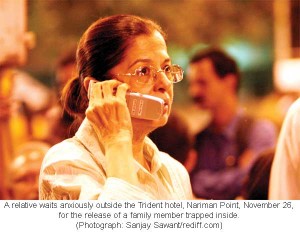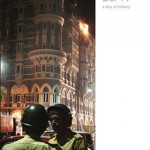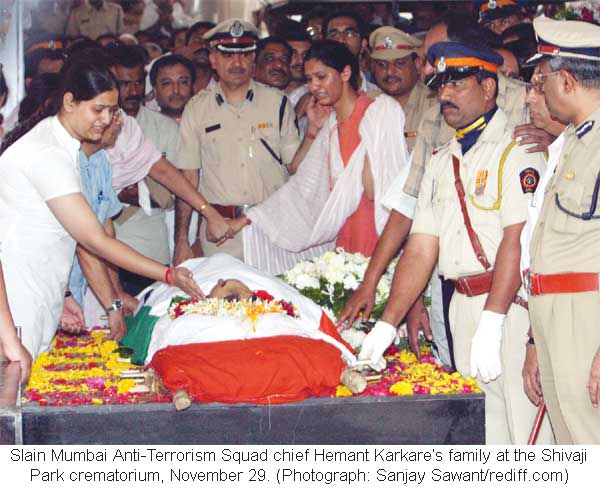Certain facts available should give an idea of the magnitude of the terrorist strikes, the like of which the world had not seen before:
- There were 13 incidents of intense firing with assault rifles at different places, including the Chhatrapati Shivaji Train (CST) terminus, the Metro Cinema junction, the Cama and Albless Hospital, outside the Olympia restaurant in Colaba, the lobbies of the Taj Mahal and Oberoi/Trident hotels, and the Leopald Café behind the Taj Mahal Hotel.
- Near the Metro Cinema junction, some terrorists hijacked a police vehicle and went around spraying bullets on passers-by.
- There were seven incidents involving explosive devices — outside the Taj Mahal Hotel, in the BPT Colony at Mazgaon, three near the Oberoi/Trident Hotels, the Colaba market and inside a taxi.
- There were some incidents of throwing hand-grenades — two of them at the Cama hospital and on Free Press Road.
Almost all the terrorist strikes took place against targets near the sea. The terrorists did not venture out into the interior.
- There were three incidents of fidayeen style (suicidal, not suicide) infiltration into buildings followed by a prolonged confrontation with the security forces before being killed. These took place in the Taj Mahal and the Oberoi/Trident hotels and in the Narriman House in Colaba, where a Jewish religious-cum-cultural centre is located, headed by a Jewish Rabbi. Jewish people of different nationalities often congregate there. The centre also has cheap accommodation for Jewish visitors from abroad.
- According to the local authorities, most of the hotel guests who were subsequently rescued by the National Security Guards (NSG) had run into their rooms and locked themselves up when the terrorist forced their way into the lobbies and restaurants and started opening fire. They were not hostages.
- However, the terrorists took six Jewish people hostages in Narriman House. They were found dead when the NSG made their entry and killed the terrorists. It was not known how they died — through bullet wounds or beheading as the jihadis normally do.
- Almost all the terrorist strikes took place against targets near the sea. The terrorists did not venture out into the interior.
Governmental experts played down the possibility of an Al Qaeda inspiration despite tell-tale signs of an Al Qaeda stamp on the strikes. They continued to maintain a silence on the possible role of sections of the Indian Muslims lest any open projection of this cost them Muslim votes. They highlighted the role of the LeT, but without drawing attention to the fact that it is a member of Osama bin Laden’s International Islamic Front (IIF) and that it had many associates in the Indian Muslim community.
The Prime Minister was unwise in reportedly suggesting or welcoming a visit to India by Lt.Gen. Ahmed Shuja Pasha, the Director-General of Pakistan’s Inter-Services Intelligence (ISI), for discussions on the Mumbai attack. One fails to understand what useful results would have come out of it. By failing to act against the LeT, its leaders and terrorist infrastructure even after ostensibly banning it on January 12, 2002, the State of Pakistan had definitely facilitated its acts of terrorism in Indian territory. By sharing the information collected by us at that stage with the ISI chief, we would have helped him in covering up the tracks of the LeT and the ISI before we could complete the investigation. The visit fortunately did not materialize as there was opposition to it in Pakistan, particularly from the Army.
One should not be surprised if the suggestion for the visit had come from the US and the Prime Minister had accepted it just as he reportedly accepted in September, 2006, the US suggestion for setting up a joint counter-terrorism mechanism with Pakistan. The American ploy would have been to divert any Indian public anger away from Pakistan and the Prime Minister should have firmly rejected it.
Three of the most gruesome acts of terrorism since India became independent have taken place in Mumbai — the March 1993 blasts, the July 2006 blasts in suburban trains and the strikes of November, 2008. It is a shame that we have not been able to protect this city effectively, which is the jewel of India. Mumbai is India’s New York and Shanghai. Look at the way the Americans have protected NY after 9/11. Look at the way the Chinese have protected Shanghai. The immediate priority of the Government should have been to set up a joint task force of serving and retired officers from Maharashtra in the Police, intelligence agencies and the Armed Forces to work out and implement a time-bound plan to ensure that 26/11 cannot be repeated again. Mumbai has till now been the gateway of India. The terrorists have exploited it. We should make it Fortress India. Foreign investors will lose confidence in India if Mumbai, where many of the corporate headquarters are located, can be attacked repeatedly with impunity by terrorists.
 The second lesson was that confidence-building measures with Pakistan should not be at the expense of national security. In the name of confidence-building, there have been too many relaxations of immigration regulations applicable to Pakistan. There has been pressure on the Government for more relaxations from the so-called Indians–Pakistanis Bhai Bhai (Indians–Pakistanis are brothers) lobby. The terrorists have been a major beneficiary of these relaxations. These relaxations have decreased the vigilance of our people. For example, hotels, which immediately used to alert the Police when a Pakistani national or a foreigner of Pakistani origin checked in, no longer do so.
The second lesson was that confidence-building measures with Pakistan should not be at the expense of national security. In the name of confidence-building, there have been too many relaxations of immigration regulations applicable to Pakistan. There has been pressure on the Government for more relaxations from the so-called Indians–Pakistanis Bhai Bhai (Indians–Pakistanis are brothers) lobby. The terrorists have been a major beneficiary of these relaxations. These relaxations have decreased the vigilance of our people. For example, hotels, which immediately used to alert the Police when a Pakistani national or a foreigner of Pakistani origin checked in, no longer do so.
The use of boats and dinghies for the clandestine transport of men and material for terrorist strikes on land is an old modus operandi (MO) used in the past against Israel. The Liberation Tigers of Tamil Eelam (LTTE) had copied it from them. The anti-India jihadis emulated their West Asian counterparts.
The use of boats for transport enables the terrorists to evade physical security checks by road, rail and air. The numerous creeks between India and Pakistan across the Bhuj area of Gujarat enable the ISI and the pro-Al Qaeda Pakistani terrorist organizations to clandestinely transport men and material by sea. Reports that the ISI had planned to use this MO for helping the Khalistani terrorists in the 1990s had led to the Border Security Force acquiring some boats which could be used for surveillance in these creeks.
The success of the terrorists in evading detection by our Coast Guard and the police revealed a serious gap in our maritime counter-terrorism architecture.
The success of the terrorists in evading detection by our Coast Guard and the police revealed a serious gap in our maritime counter-terrorism architecture. If this gap is not quickly identified and closed, the vulnerability of the Bombay High off-shore oil installations and the nuclear establishments to terrorist attacks from the sea would be increased. Many of our nuclear and space establishments — not only in Mumbai, but also in other areas — are located on the coast and are particularly vulnerable to sea-borne terrorist attacks.
The stamp of Al Qaeda was evident in the selection of targets. The Taj Mahal Hotel, old and new, the Oberoi-Trident Hotel and the Narriman House were the strategic focus of the terrorist operation. The terrorist strikes in other places such as the railway station, a hospital, etc and instances of random firing were of a tactical nature intended to create scare and panic.
The strategic significance of the attacks on the two hotels from Al Qaeda’s point of view arose from the fact that these hotels are the approved hotels of the US and Israeli Governments for their visiting public servants and for the temporary stay of their consular officials posted in Mumbai till a regular house is found for them. These hotels are also the favorites of the foreign business elite visiting or living in Mumbai.
 Al Qaeda and pro-Al Qaeda organizations have been critical of India’s close co-operation with Israel and the US. In the past, the ISI had also shown an interest in having Indo–Israeli relations disrupted through terrorist attacks on visiting Israeli nationals in India. In 1991, it had instigated an attack by the Jammu & Kashmir Liberation Front on some Israeli tourists in Srinagar by alleging that they were really Israeli counter-terrorism experts.
Al Qaeda and pro-Al Qaeda organizations have been critical of India’s close co-operation with Israel and the US. In the past, the ISI had also shown an interest in having Indo–Israeli relations disrupted through terrorist attacks on visiting Israeli nationals in India. In 1991, it had instigated an attack by the Jammu & Kashmir Liberation Front on some Israeli tourists in Srinagar by alleging that they were really Israeli counter-terrorism experts.
The attacks on the foreigners in the hotels were selective and not indiscriminate. Available reports indicated that the terrorists were looking for American, British and Israeli nationals — particularly visiting public servants among them with official or diplomatic passports.






The greatest failure of the Indian Leadership in Delhi after 26/11 was that it failed to retaliate against Pakistani/ISI military targets, selectively or demonstratively, even after it was abundantly clear that this was a Pakistani military operation. It fell for the Pakistani administration line of blaming ‘stateless actors’ as a shield to hide behind and avoid confrontation at the military level for reasons none other than a lack of leadership acumen. Mr. Chidambaram went on his usual spin demanding of Pakistan to arrest and prosecute the perpetrators as if we all lived in a la-la land of wishful surprises. How many more lessons does India need to be given before it realizes that it’s terrorism war from Pakistan is a war with Pakistani military which employs Hafeez Said and others who are willing to sacrifice lives endlessly for their cause while the Pakistani military pulls the string without getting its nose bloody?
I guess the first suicidal attack was on the Parliament.
The most profound mistake in thinking through the Who’s and Why’s of the 26/11 is to accept the popular line of the Security Establishment in India that it was an act of a fringe group and not the Pakistan government. Nothing can be far from the truth. The terrorist group which committed the Mumbai massacre was a well trained Pakistani military team, an elite group similar to the seal team of US which killed Bin Laden in the dark of night inside Pakistan. How else could the Pakistani terrorists have sailed 500 miles on high seas from Karachi to Mumbai, zeroed in on a predetermined landing site better than the marines landing in Normandy on D-Day, moved into position in the presence of local security, and went from one target to another? Furthermore, while this group was committing their carnage, the Pakistani military was in full command monitoring their actions and directing them to targets. It is time we accept the fact that the LeT, the so called fringe group is actually a department of the Pakistani Military with the charter to inflict 1000 cuts on India. If the LeT was not part of the Pakistani establishment, Hafiz Saeed would be dead or behind the bars in Pakistan. This is actually a very wise and a low cost investment for Pakistan since they cannot take on Indian military in a frontal conflict. The bottom line is that the Indian citizens are paying a price for the faulty intelligence and a lack of security wherewithal of India.